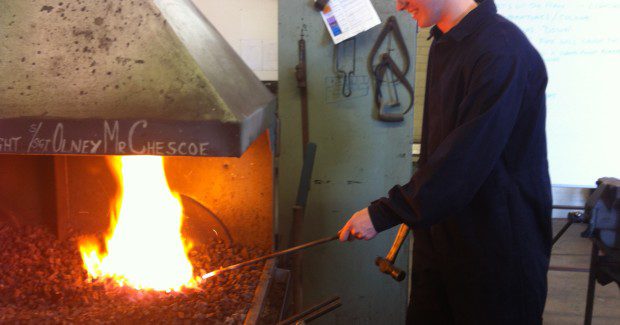Working in the Line of Fire
Line of fire injuries remain an enigma. here are some reasons why – regardless of engineering controls, guarding or bypass interlocks – workers that continue to put themselves into the line of fire will eventually die on the job.
Posted: October 24, 2013
When someone dies in the workforce through no fault of his or her own it’s undeniably a tragedy. But in many people’s minds, line of fire injuries — those injuries that result when a worker places his or her body in the direct path of a serious hazard — the injured worker must bear at least some culpability for his or her injury. It’s especially easy to dismiss a line of fire injury as the worker’s “own stinking fault,” but is it?
Before I continue I should disclose something about myself that could bias me on this topic: my grandfather died on the job from a line of fire injury. As a farmer in the 1950s, he left a lucrative career installing conveyor belts — a job that required extensive travel — so that he could spend more time at home with his family. He was driving a tractor that was struck by a speeding locomotive at a poorly marked crossing. Witnesses said the train was going upward of 80 mph. His view was at least partially obscured by overgrown bushes near the tracks and he was either legally deaf or close to it.
He left behind a widow and four daughters (one of whom was developmentally disabled) who would eke out a hardscrabble living, financially and emotionally crippled by his death; a family laid waste by a single moment. While there were many things that factored into my grandfather’s untimely demise, the fact remains that in the last moments of his life he made a decision to place himself in the line of fire. As you might expect, I spent a lot of time thinking about the circumstances of my grandfather’s death, I don’t attribute it to shaping my view of worker safety, but I suppose that’s inevitable.
My grandfather isn’t alone; the Bureau of Labor Statistics reports that 17 percent of all workplace fatalities in the U.S. are the result of line-of-fire injuries. Suffice to say that line-of-fire injuries raise a lot of questions; questions, sadly, to which we will most likely never get satisfactory answers.
WHAT WERE THEY THINKING?
I have always believed in two simple truths about worker injuries: 1) nobody wants to get hurt and 2) the process isn’t designed to hurt them. If these things were really true, then why would anybody ever knowingly put himself or herself in the line of fire? Simple:
They don’t believe they are placing themselves in real danger. No one in his or her right mind expects to be killed when they place themselves in the line of fire. Let’s face it: the primary role of our central nervous system is to keep us alive, and as long as that is functioning properly we generally aren’t looking to kill ourselves.
Too often workers who place themselves in the line of fire are making a decision based on imperfect information — they either assume that something is true when it is not, or they assume something is not true when it is. In the case of my grandfather we can only speculate, of course, but for the sake of argument let’s say that he knowingly and deliberately put himself in the line of fire and crossed those railroad tracks without looking or stopping long enough.
Since there is no evidence that he was suicidal — by all accounts he was good-natured, popular, and happy in life — we can infer that he didn’t deliberately place himself in the line of fire thinking that he would most likely be killed. This means we can speculate that he believed that the likelihood that a train would approach unseen, in fact, undetected, were immeasurably small. Had he believed that there was a strong possibility that a train would strike him, he never would have taken the chance.
They believe the time of exposure is small enough to protect them. How many line of fire injuries are the result of “I’m only going to be in there for a second” thinking? It’s a big temptation to risk it when you believe that your probability of injury is directly proportionate to the length of exposure to the hazard. Unfortunately, probability doesn’t work that way and too few workers truly comprehend the dangers that some line of fire hazards pose irrespective of the length of exposure. If a worker makes contact with a piece of energized equipment of sufficient power, he or she will be electrocuted even if he or she touches the equipment just for a second.
Familiarity breeds contempt. For most of us, the longer we work around a hazard or, in this case, the more we place ourselves in the line of fire and suffer no negative consequences, the less we respect a hazard’s ability to harm us. We innately teach ourselves that an activity is safer than it is. As we become more comfortable working around a hazard, we convince ourselves that we will not get hurt “as long as we’re careful” when, in fact, we are not.
The job is too difficult to get done without placing workers in the line of fire. Much as we would love to place the blame squarely on the shoulders of the injured worker, some jobs are so poorly designed or safety procedures are so onerous that no reasonable worker will work within process. In fact, I know of many manufacturers that continue to have standard operating procedures that place the workers in the line of fire. These cases are the most troubling because, in general, workers believe that if they follow the standard operating procedures they will not be injured, even though some processes are grossly unprotected.
They aren’t thinking. Research has shown that the average worker makes 8 mistakes an hour (this number falls to around five for workers in “high consequence industries — healthcare, aviation, oil & gas, energy, etc.). These are human errors; unintended foul-ups. Five mistakes an hour, eight hours a shift, five shifts a week amounts to mistakes in the neighborhood of 10,400 mistakes in the course of a work year. Obviously this number is much higher for workers who work longer shifts, six- or seven-day workweeks, or any number of a host of other factors that would extend the worker’s work year from the traditional 2,080 hours in a typical year.
Inevitably, some of these mistakes will place the worker in the line of fire. The incidence of human error increases when a person is sleep deprived, under stress, using drugs or alcohol or is otherwise preoccupied. Something as simple as bright lights can dramatically increase a person’s tendency to take risks.
Line of fire injuries may always remain an enigma and, as one safety veteran once told me after learning of the death of veteran colleague caused by several line of fire violations, “I don’t know how to save worker’s from themselves.” I don’t know either and, in truth, nobody really does. We try engineering controls, but people remove guards and by-pass interlocks. We put administrative controls in place, but workers ignore them. We require PPE only to have workers grouse about wearing it.
From all of this, only one thing is certain: if workers continue to put themselves into the line of fire, they will continue dying on the job.

















